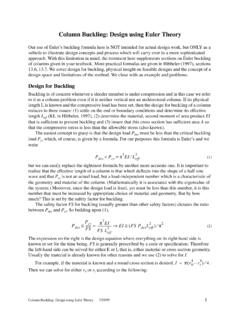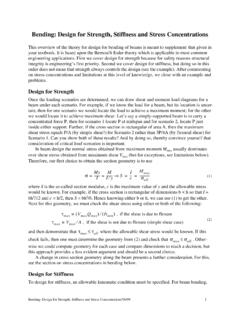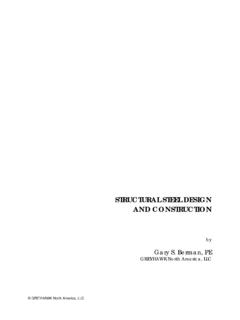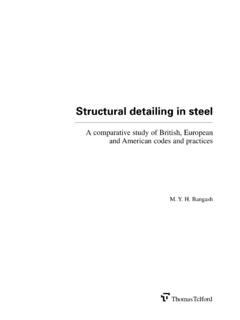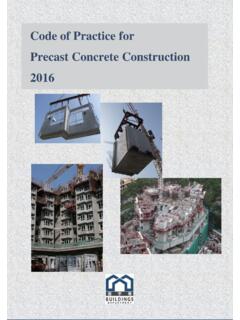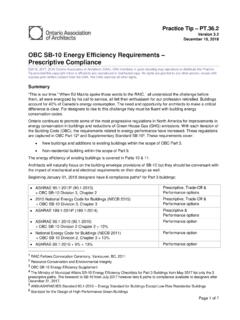Transcription of Introduction to Standards and Specifications for Design in ...
1 1 Introduction to Standards and Specifications for Designin Mechanics or Strength of MaterialsGeorginna Lucas and Lisa HatcherPurposeThe purpose of this Introduction to Specifications for Design is (1) to make users aware of variousstandards which may be considered during the Design process and (2) to assist users in finding thestandards needed for a specific Design are Standards ? Standards are an important part of our society, serving as rules to measure or judge capacity,quantity, content, extent, value and quality. Some Standards take the form of an actual item suchas the atomic clock which serves as the reference for measuring time throughout the world. Othersset criteria for use and practice in industry and for products used in everyday life. Thisintroduction, however, deals primarily with Standards that set a level of adequacy for structuresand machines.
2 It is these Standards , above all others, which must be addressed before anyengineering Design project can be started. How are Standards developed? The International Standards Organization (ISO) coordinates Standards world-wide. Under thisumbrella are representative organizations from many countries; for the , it is the AmericanNational Standards Institute. ANSI coordinates many national technical Standards organizations(for a listing of some organizations and their acronyms see Table 1). Within ANSI guidelines, eachstandards-writing and -issuing organization has its own method for developing Standards . Asubject listing of Standards written by prominent organizations recognized and approved by ANSIis given in Table American Society of Mechanical Engineers is one such approved organization, andwhat follows is a brief description of their Standards -development process.
3 After a new standard issuggested, the Council on Codes and Standards decides if ASME should investigate it. If theCouncil decides the project is worthy, it then determines the scope of the project and assigns it tothe appropriate committee. The committee then develops the criteria needed to address the scopeand purpose of a code or standard. Finally, after many drafts and votes, the standard is acceptedby the committee. From there it is announced in ASME s Mechanical Engineering Magazine andthe ANSI Reporter so that the public can review and comment on the standard. If a comment cannot be resolved by the proposing committee, then there shall be a system of hearings and appeals to settle the does the numbering system for Standards work? There are almost as many different ways of numbering Standards as there are Standards -issuingorganizations, although many follow a similar format.
4 First comes the acronym of the organizationwhich issued the standard. For example, ASTM comes before those Standards originating fromthe American Society for Testing and Materials. This is usually followed by a letter designationthat denotes the general classification of the standard. ASTM uses letters to denote certainmaterials:2 A -- ferrous metals and products B -- nonferrous metals and products C -- cementitious, ceramic, concrete and masonry materials D -- miscellaneous materials and products E -- miscellaneous subjects F -- end-use materials and products AG -- corrosion, deterioration, weathering, durability and degradation of materials and products ES -- emergency Standards . A sequential number follows the letter. If the standard is written using metric units but has acompanion standard in inch-pound units (or any other type of units), it is then followed by an M toidentify the metric standard.
5 Next, usually following a hyphen, is either the full year in which thestandard was issued or else the last two numbers of that year (89 for 1989). Some organizationswill change this number to indicate the year in which the standard was last revised; others place thisinformation in parenthesis after the title of the standard. Should the year be followed by a lowercase letter, it indicates that there was more than one revision of the standard during that year ("a"indicates the second revision, "b" indicates the third, etc.).An example of an ASTM standard is standard ASTM F468M-93: Nonferrous Bolts, HexCap Screws and Studs for General Use (Metric). As you can see, using the information in theprevious paragraph, the number itself provides an enormous amount of information. We knowjust by looking at it that the standard to which it refers is issued by the American Society forTesting and Materials, that it deals with an end-use material or product, and that it is written usingmetric of Standards : There are many sources available to locate the necessary Standards for any Design project.
6 Whilethey do not hold in-depth information on individual Standards , they do provide informationrelevant to many topics. Some of the information available in these references includes lists ofstandards-related organizations, cumulative subject indexes of Standards (giving relatedorganizations, the Standards themselves, or Standards -related periodicals), and numeric lists available are searchable indexes that can be found on many Standards -issuingorganizations web pages. They allow users to search by keywords in the standard or by itsnumber. While these pages do not allow access to the details contained in the Standards , they dogive the number and title of the standard. In some cases they contribute a brief description of thetype of information included. See Table 2 for web covered here: There are an incredible number of Standards -issuing organizations throughout the world.
7 In thisintroduction we summarize several of those which issue Standards pertinent to Design in Mechanicsof Materials. They are arranged in alphabetical order by the organization s name. Topics rangefrom materials used in Design to Industries Association of America, ~aia/ AIA represents America s leading manufacturers of commercial, military, and business aircraft,helicopters, aircraft engines, missiles, spacecraft, and related components and equipment. AIAprovides many of the country s national aerospace Standards , which cover such topics as screws,bolts, nuts and washers; wires; tube assembly; twin seaplane floats; shackle components forground support equipment; angles; tees and Aluminum Association, AAI is the trade association for producers of aluminum and semi-fabricated aluminumproducts as well as aluminum recyclers. AAI provides leadership to the industry through itsprograms and services which aim to increase the use of aluminum, remove impediments to itsadvancement and assist in achieving the industry s environmental, societal, and publishes Standards for aluminum and its alloys for various shapes and types ofmanufacturing, as well as for aluminum Design in general.
8 Topics covered include: minimum and typical mechanical properties for regular and welded aluminum alloys allowable stresses for bridge type structures allowable stresses for building and similar type structures allowable uniform beam loads for given depth, weight, and span allowable stresses for mechanical connections dimensions for various types of bolts, nuts and washers comparative characteristics and applications of aluminum alloysAlso given is information such as designation, sizes, weights, moment of inertia and radius ofgyration for many different types of channels, flanges, I-beams, angles, tee and zee sections,round tubes, pipe, square tubes, and rectangular tubes. There are references available, to be usedwith AAI s Standards , which give in-depth explanations, both qualitative and quantitative, on howto analyze aluminum elements used in American Institute of steel AISC represents and serves the structural steel industry in the Its purpose is to use researchand development, education, technical assistance, standardization and quality control to expand theuse of fabricated structural Standards it publishes deal with steel including.
9 steel beams composite beams steel connections allowable stress Design in steel construction standard practices for steel buildings and bridges allowable stress Design Specifications for structural joints Specifications for structural steel buildings as pertaining to the allowable stress Design of singleangle members load and resistance factor Design of simple shear connections and moment shears reactions for continuous highway bridges4 The American Iron and steel promotes the use of steel by providing Standards for high-quality products, steel production,safety and environmental responsibility. AISI develops Standards and publications regarding: critical issues of automotive steels - weight, cost, safety, recycling, and manufacturing shear resistance of walls with steel studs welded steel pipe and steel plate engineering data properties of bridge steels Design and fabrication of cold-formed steel American National Standards serves as the administrator and coordinator of the United States private sector voluntarystandardization system and promotes and facilitates voluntary consensus Standards and conformityassessment systems.
10 ANSI itself does not develop American National Standards , it facilitatesdevelopment through the establishment of consensus among qualified groups, who are accreditedunder one of its three methods; organization, committee, or by voting. ANSI is also the only to two major international Standards organizations, the International Organization forStandardization, where it is one of only five permanent members on the governing ISO Council,and the International Electrotechnical Commission (IEC).The American Society of Civil is America s oldest national engineering society. It seeks to advance professionalknowledge and improve the practice of civil engineering by serving as the leading professionalorganization supporting both civil engineers and those in related fields. It also serves as the focalpoint for the development and transfer of research results and technical, managerial and policy-related information and as a catalyst for effective and efficient service through cooperation withother engineering and related organizations.

